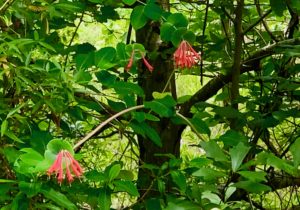By Mary Reid Barrow
Meeting up with a flower in the wild that you have growing in your garden is always a special surprise.
But as many natives as I’ve purchased and planted in my yard, I rarely see one of them growing in a place like First Landing State Park. I’m not counting buttercups, violets, dandelions and the like.
A couple of years ago, when I came across several sweet pepperbushes in bloom along a trail in First Landing, I kept asking myself what those plants were and why were they so familiar looking?
Then, when it dawned on me that it was the same sweet pepperbush that I had growing in my yard, I was so pleased that I had the plant and that I could make that connection.
The same thing happened again recently when I was walking with LRNow’s Pearl Home Coordinator, Terri Gorman. She saw the bright red-orange tubular blooms of the coral honeysuckle back among the trees off the trail.
What is that, we both asked, and then it dawned on us that it was coral honeysuckle. We each have it growing in our yards because, like my sweet pepperbush, we both had planted the honeysuckle in our gardens.
But coral honeysuckle in the park is part of nature’s garden design. Though it sure added stand-out color among the green forest to our appreciative eyes, nature has given coral honeysuckle way more purpose than to just please us humans.
Its colorful blooms attract hummingbirds and butterflies that can navigate the long tubular flowers to get to the sweet nectar.
Coral honeysuckle serves as a host plant to over 30 caterpillars, says “Native Plants for Southeast Virginia.” Clearwing moth caterpillars grow up on coral honeysuckle leaves. They are the fun, day-flying moths that look a little like hummingbirds.
And in the fall, the honeysuckle’s bright red berries are food for any number of birds, including robins and thrushes.
Unlike the non-native Japanese honeysuckle that will barge in and take over wherever it can while doing nothing beneficial for the birds and insects, coral honeysuckle is well behaved in very way.
It even taught me to keep my eyes open for the little things when I walk in the park. No telling how many of my plants’ relatives are growing there right under my nose and I just don’t see them.
Do you have a favorite tree or plant with a story to tell? What relationships have you observed between plants and critters? Who eats whom? Who has babies where? Send an email to maryreid@lrnow.org
